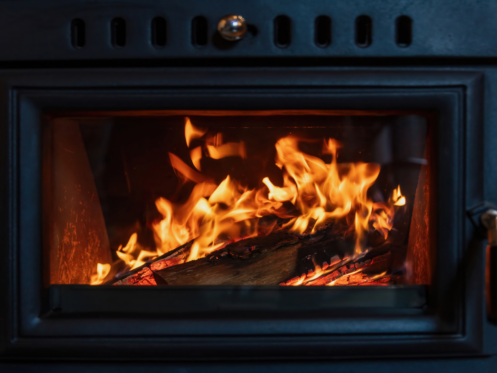Furnace carbon monoxide is a dangerous gas as it’s hard to detect increasing levels of carbon monoxide levels inside a home. Being knowledgeable and taking proactive steps is the best way to protect your family from carbon monoxide.
Furnace Carbon Monoxide: What is it?
As carbon monoxide is a type of gas that is lighter than air, it can move throughout your home quickly. The characteristics of this toxic gas include being colorless, odorless, and tasteless. This can quickly create a life-threatening situation from breathing in these harmful fumes. However, the (danger level) depends on the length of exposure and the levels of carbon monoxide being released.
How is it Produced?
In fuel burning appliances like furnaces, carbon monoxide is created naturally. When functioning properly, a furnace will draw in enough oxygen to burn the fuel cleanly and vent out harmful gasses. However due to problems with the exhaust ventilation, toxic gasses will leak into your home due to the negative pressure. Furthermore, the lack of oxygen for the flame will create incomplete combustion and higher amounts of carbon monoxide.
What Causes Carbon Monoxide in a House?
Causes of carbon monoxide pollution include disruptions in the burning process or shortage of available oxygen for the flames. From wood and coal to natural gas, carbon monoxide is created during the burning process. So homes that use fuel-burning appliances are more at risk for carbon monoxide contamination. In addition, despite most carbon monoxide poisonings happening in winter, homeowners need to be careful at all times with these types of appliances:
- Auto Exhaust / Idling Vehicles, Power Tools, and Lawn Equipment (especially if stored any of these items in an attached garage as the gas could seep into your home)
- Cooking Appliances like Gas Stoves and Ovens
- Clothes Dryers
- Clogged, Deteriorating, or Improperly installed chimneys
- Fireplaces (gas and wood-burning)
- Furnaces (oil, wood, gas, or coal)
- Gas or fuel-burning appliances in cabins or campers (barbecue grills, pool / spa heaters)
- Generators
- Incorrectly Installed Venting Systems
- Unvented Appliances
- Unvented Space Heaters (Typically Gas-Powered)
- Water heaters
- Wood stoves
CO Poisoning Symptoms
Besides being unable to see or smell a carbon monoxide leak, another reason why it’s so dangerous is because its symptoms are similar to the flu or food poisoning. In addition, prolonging the exposure further disrupts the body’s transport of oxygen to the organs. The lack of oxygen can lead to irreversible brain damage and death if not caught in time. The typical symptoms of carbon monoxide poisoning include:
- Blurry Vision
- Cardiac Arrest / Seizures
- Chest pain
- Disorientation / Confusion / Hallucinations
- Dizziness / Weakness
- Death
- Headache
- Loss of Hearing
- Loss of Consciousness or Coma
- Respiratory Failure
- Rapid Heartbeat
- Shortness of Breath
- Upset Stomach
Carbon Monoxide from Furnace: What to do When There’s a Leak
If you discover or suspect a carbon monoxide leak, have everyone including pets evacuate the house to move to fresh air. Checking everyone for carbon monoxide poisoning symptoms is critical. Call 911 for anyone experiencing any of those symptoms. Otherwise use the non-emergency number to alert the local fire department about a gas leak. If it’s safe to do so, shut down the leaking appliance and open windows for ventilation. It’s important to have the appliance inspected and serviced by a licensed professional before further use.
How Can You Prevent Carbon Monoxide Poisoning?
Rather than asking which is the best precaution against carbon monoxide poisoning? It’s better to take multiple simple yet important steps that can protect your family such as:
- Routine maintenance and cleaning for furnaces and fireplaces before each season
- Use electrical space heaters instead of fuel-burning unless the fuel-burning space heater is well-ventilated by open windows or doors. Do not sleep while using a fuel-burning space heater.
- Always open the garage door before starting up your vehicle. Never leave running vehicles in an enclosed garage or barn. Keep in mind that carbon monoxide can leak into your home from an attached garage.
- Use portable heaters, lanterns, and gas stoves in outdoor areas only and never sleep with them in enclosed spaces. Tents, campers, and vehicles with these items running can cause carbon monoxide poisoning, especially if camping at high altitudes.
- Never use a gas-powered generator within an enclosed space. It is extremely dangerous to use a generator while it’s in your home, basement, or garage. The recommended distance for running a generator outside your home is at least 20 feet away. Be sure to keep it away from all doors, windows, and vents.
- Always use gas appliances for they are made for and never try to heat your home with a gas stove or oven.
- If/when doing a remodel, always make sure the chimney and all vents are free of blockage or covers.
- Only use solvents while outdoors or in well-ventilated areas and make sure to follow all the safety label precautions.
- Make sure you have CO detectors installed and check the batteries at least twice a year. Keep in mind you should replace CO detectors every 5-7 years depending on the model. In addition if you have a camper or boat, be sure to check their CO detectors before each season.
- If your home is exposed to high carbon monoxide levels, always find and repair the malfunctioning appliance before staying.
- Contact HVAC professionals like Satterlee to help keep your family safe and your heating system running properly this winter!


